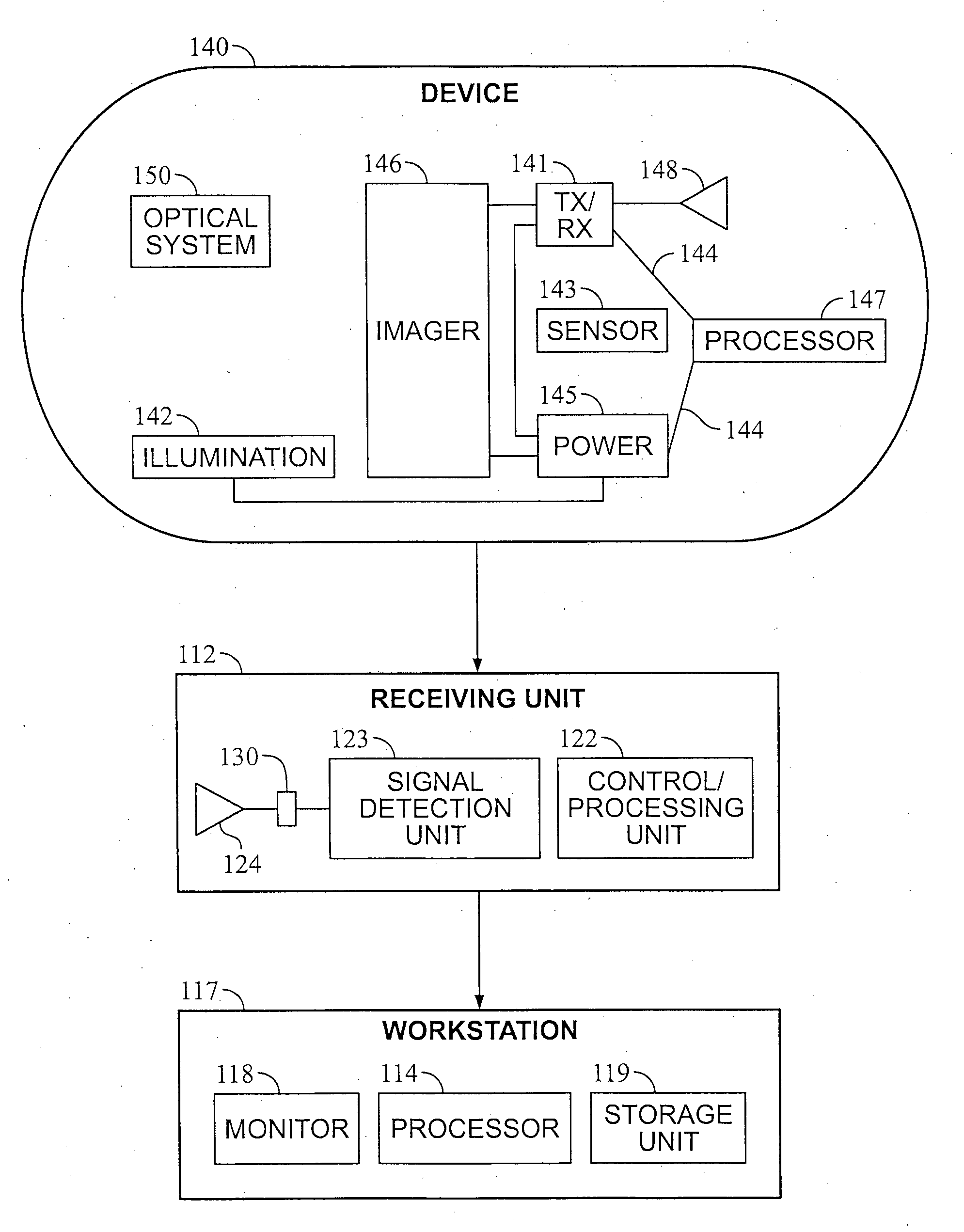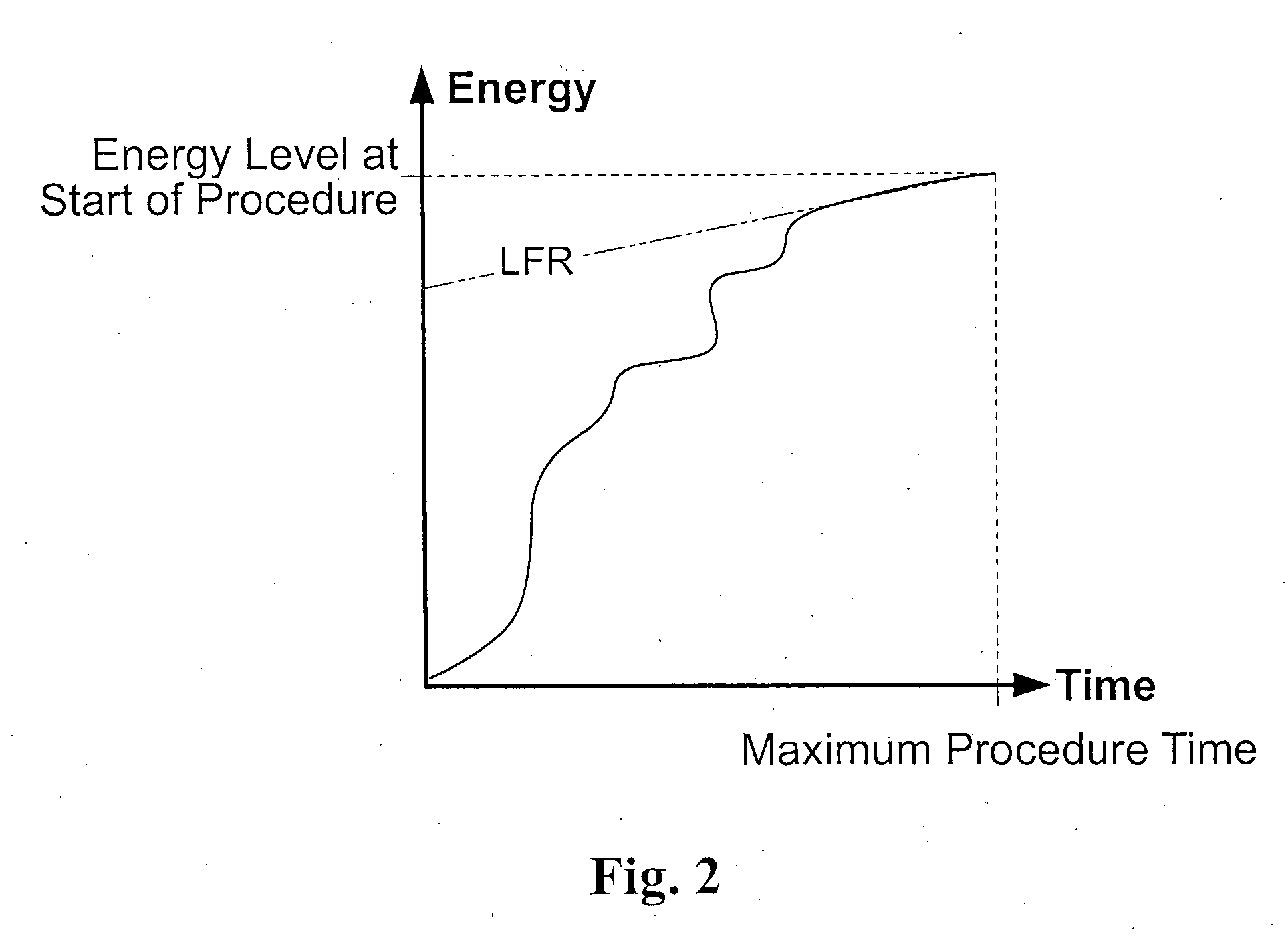System and method for controlling power consumption of an in vivo device
a technology power consumption, applied in the field of system and method for controlling power consumption of in vivo devices, can solve the problems of limited space available for capsule components including their energy source, size of energy source, and limitation of power available for capsule operation, etc., and achieve the effect of controlling energy consumption
- Summary
- Abstract
- Description
- Claims
- Application Information
AI Technical Summary
Benefits of technology
Problems solved by technology
Method used
Image
Examples
example 1
[0085]In a first example, power source 145 may have substantially no energy loss due to storage, e.g., when device 140 is immediately used, (StorageEnergyReduction==0). The energies used to capture each frame in each of modes 0-4 are described in Table 1. A clock in or operated by for example processor 147 (e.g., a 8.1 MHz clock) may measure the time in which device 140 operates each mode, e.g., as follows:[0086]7 min in Mode 0 (1680 frames),[0087]30 minutes in Mode 1 (1440 frames),[0088]1 hour in Mode 2 (14400 frames),[0089]57.4917 minutes in Mode 3 (124182 frames), and[0090]a total estimated procedure time of 9 hours.
A processor may substitute the values above into equation (1), for example, as follows:
52-0-(1.09933600*1680+0.60263600*1440+1.09933600*14400+0.53913600*124182)-(9-2.5749)*1.0993360014*3600=52-(1.09933600*1680+0.60263600*1440+1.09933600*14400+0.53913600*124182)-(9-2.5749)*4*1.0993=0.000049
[0091]The resulting equation (1) has a value very close to zero, though greater ...
example 2
[0118]In a second example, power source 145 may suffer an energy loss due to storage, e.g., when device 140 has been stored for 12 months. The average energies used to capture each frame in each of modes 0-4 are listed in Table 1. A clock in processor 147 (e.g., a 8.1 MHz clock) may measure the time in which device 140 operates each mode, e.g., as follows:[0119]7 min in Mode 0 (1680 frames),[0120]30 minutes in Mode 1 (1440 frames), and[0121]a total estimated procedure time of 9 hours.
A processor may calculate the BaseEnergy (mAh) of device 140, e.g., as follows:
BaseEnergy=BatteryFullCap-StorageEnergyReduction-∑iEngSti*Counteri=52-(0.52+0.219)*12-1.09933600*1680-0.60263600*1440=42.378mAh
[0122]The processor may determine the maximal number, X, of frames that may be captured at the higher than minimum frame rate, e.g., of Mode 3, without depleting the energy reserve, when device 140 was stored for 12 months, e.g., by substituting values into equation (4) as follows.
X≦BaseEnergy-Procedu...
example 3
[0124]In a third example, power source 145 may have substantially no energy loss due to storage, e.g., when device 140 is used soon after manufacture, (StorageEnergyReduction==0). The energies used to capture each frame in each of modes 0-4 are listed in Table 1. A clock in processor 147 (e.g., a 8.1 MHz clock) may measure the time in which device 140 operates each mode, e.g., as follows:[0125]7 min in Mode 0 (1680 frames),[0126]30 minutes in Mode 1 (1440 frames), and[0127]a total estimated procedure time of 9 hours.
If there is no energy loss due to storage, the BaseEnergy (mAh) of device 140 may be calculated, e.g., as follows:
BaseEnergy=BatteryFullCap-StorageEnergyReduction-∑iEngSti*Counteri=52-0-1.09933600*1680-0.60263600*1440=51.246mAh
With no energy depletion due to storage, e.g., values may be substituted into equation (4) as follows:
X≦BaseEnergy-ProcedureMaxTime-TAFRStartTLFR*EngStLFREngStHFR-THFRTLFR*EngStLFRX=51.246-9-0.61670.25 / 3600*1.0993 / 36000.5391 / 3600-436*1.0993 / 3600=36...
PUM
 Login to View More
Login to View More Abstract
Description
Claims
Application Information
 Login to View More
Login to View More - R&D
- Intellectual Property
- Life Sciences
- Materials
- Tech Scout
- Unparalleled Data Quality
- Higher Quality Content
- 60% Fewer Hallucinations
Browse by: Latest US Patents, China's latest patents, Technical Efficacy Thesaurus, Application Domain, Technology Topic, Popular Technical Reports.
© 2025 PatSnap. All rights reserved.Legal|Privacy policy|Modern Slavery Act Transparency Statement|Sitemap|About US| Contact US: help@patsnap.com



